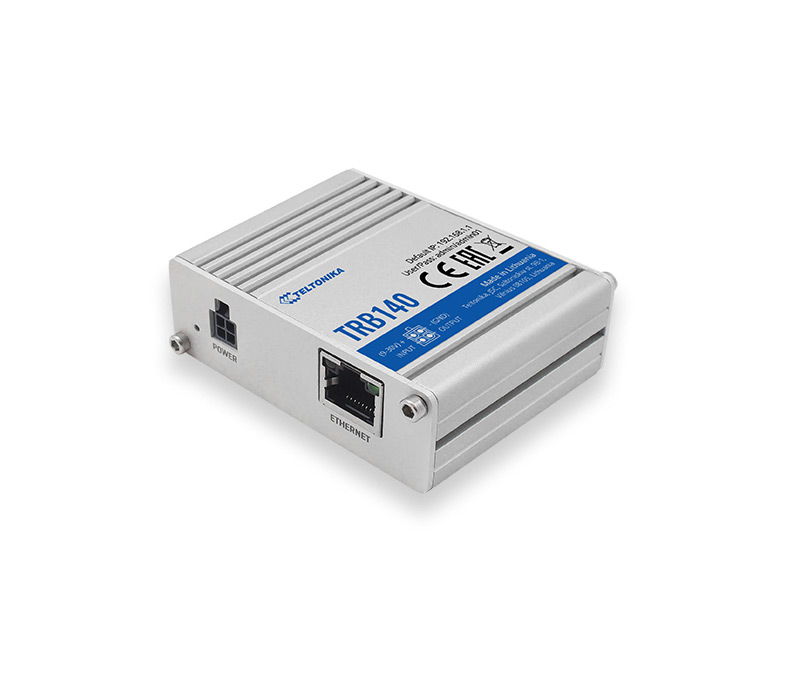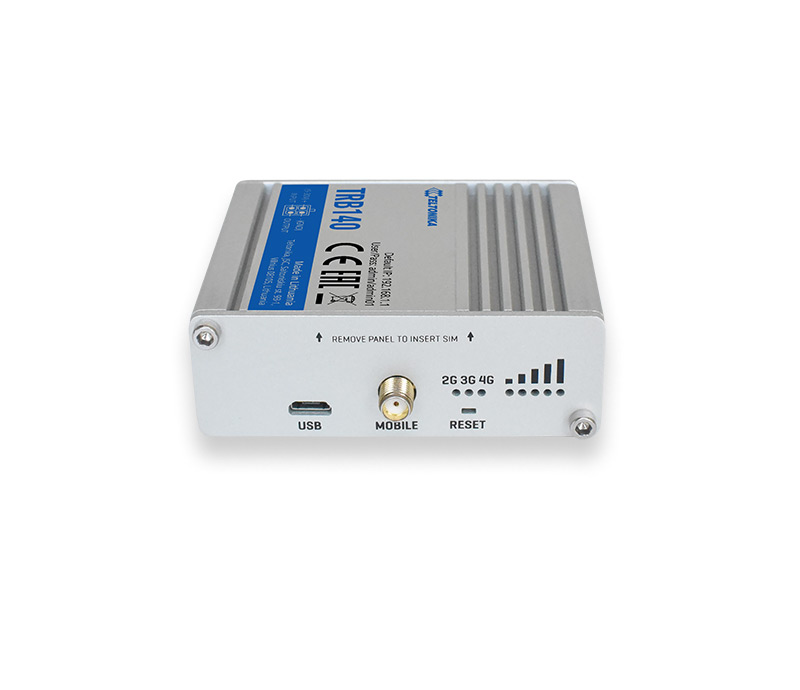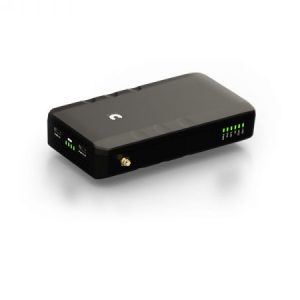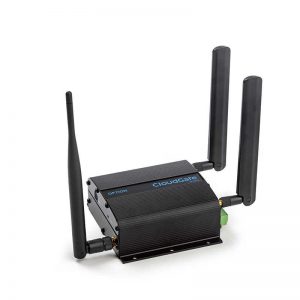Le routeur industriel TRB140 de Teltonika est équipé d’un port Ethernet, d’entrées / sorties numériques et d’un port micro-USB.
Passerelle IoT au design compact, ce boitier robuste est conçu pour des applications industrielles où une connexion Internet fiable doit être garantie. Le TRB140 offre un large éventail de fonctionnalités logicielles, telles que le contrôle SMS, le pare-feu, OpenVPN, IPsec… mais aussi la prise en charge FOTA et RMS.

Caractéristiques principales du TRB140
- LTE Cat4/3G/2G
- Fente SIM : mini SIM 2FF
- Connecteur d’antenne : 1 x SMA pour LTE
- Ethernet : 1 x 10/100/1000 Mb/s
- Entrée / sortie : 2 x entrées/sorties numériques/analogiques (configurables)
- CPU : processeur ARM Cortex-A7 1,2 GHz
- RAM : 128 Mo (50 Mo disponibles pour les utilisateurs)
- Flash : 512 Mo (70 Mo disponibles pour les utilisateurs)
- Tension d’entrée : 9 – 30 V c.c.
- Raccordement électrique : prise de courant continu industrielle à 4 pôles
- Port de configuration : carte réseau virtuelle via un port micro USB
- Indicateurs LED : LED d’état de fonctionnement, de signal, de réseau et de données
- Température de service : – 40 °C à 75 °C
Logiciel
- Système d’exploitation : Linux avec Yocto SDK (offrant une grande personnalisation)
- Réseaux : NAT, routage statique / dynamique, pare-feu (port forward, règles de trafic, règles personnalisées), OpenVPN, DDNS ( >25 fournisseurs de services supportés)
- Gestion à distance : support RMS, support FOTA, SSH, CLI, utilitaires SMS (statut/configuration)
- Statuts de surveillance : redémarrage ping, redémarrage périodique
- Caractéristiques supplémentaires : connexion Internet via une interface réseau virtuelle USB
Caractéristiques techniques du TRB140
| MOBILE | |
| Mobile module | 4G (LTE) – Cat 4 up to 150 Mbps, 3G – Up to 42 Mbps, 2G – Up to 236.8 kbps |
| Bridge | Direct connection (bridge) between mobile ISP and device on LAN |
| Status | Signal strength (RSSI), SINR, RSRP, RSRQ, EC/IO, RSCP Bytes sent/received |
| SMS/Call | SMS status, SMS configuration, Call utilities |
| ETHERNET | |
| LAN | 1 x RJ45 port, 10/100/1000 Mbps, supports auto MDI/MDIX |
| NETWORK | |
| Network protocols | TCP, UDP, IPv4, IPv6, ICMP, NTP, DNS, HTTP, HTTPS, SSL v3, TLS, SSH, DHCP, MQTT, Wake on LAN (WOL) |
| Routing | Static routing |
| Connection monitoring | Ping Reboot, Periodic Reboot, LCP and ICMP for link inspection, Wget |
| Firewall | Port forwards, traffic rules, custom rules |
| DHCP | Static and dynamic IP allocation |
| DDNS | Supported >25 service providers, others can be configured manually |
| SECURITY | |
| Authentication | Pre-shared key, digital certificates, X.509 certificates |
| Firewall | Pre-configured firewall rules can be enabled via the WebUI, unlimited firewall configuration via CLI; NAT; NAT-T |
| Access control | Flexible access control of TCP, UDP, ICMP packets, MAC address filter |
| VPN | |
| OpenVPN | Multiple clients and a server can run simultaneously, 12 encryption methods |
| OpenVPN Encryption | DES-CBC, RC2-CBC, DES-EDE-CBC, DES-EDE3-CBC, DESX-CBC, BF-CBC, RC2-40-CBC, CAST5-CBC, RC2-64-CBC, AES-128-CBC, AES-192-CBC, AES-256-CBC |
| IPsec | IKEv1, IKEv2, supports up to 5 x VPN IPsec tunnels (instances), with 5 encryption methods (DES, 3DES, AES128, AES192, AES256) |
| GRE | GRE tunnel |
| PPTP, L2TP | Client/Server services can run simultaneously |
| MONITORING & MANAGEMENT | |
| WEB UI | HTTP/HTTPS, status, configuration, FW update, CLI, troubleshoot, system log, kernel log |
| FOTA | Firmware update from sever, automatic notification |
| SSH | SSH (v1, v2) |
| SMS | SMS status, SMS configuration |
| MQTT | MQTT Broker, MQTT publisher |
| JSON-RPC | Management API over HTTP/HTTPS |
| Modbus | Modbus TCP status/control |
| RMS | Teltonika Remote Management System (RMS) |
| SYSTEM CHARACTERISTICS | |
| CPU | ARM Cortex-A7 1.2 GHz CPU |
| RAM | 128 MB (50 MB available for userspace) |
| FLASH memory | 512 MB (70 MB available for userspace) |
| FIRMWARE / CONFIGURATION | |
| WEB UI | Update FW from file, check FW on server, configuration profiles, configuration backup, restore point |
| FOTA | Update FW/configuration from server |
| RMS | Update FW/configuration for multiple devices |
| Keep settings | Update FW without losing current configuration |
| FIRMWARE CUSTOMIZATION | |
| Operating system | RutOS (OpenLinux based Linux OS) |
| Supported languages | Busybox shell, Lua, C, C++ |
| Development tools | SDK package with build environment provided |
| INPUT/OUTPUT | |
| Configurable I/O | 2 x Configurable Digital Inputs/Outputs |
| Events | SMS status |
| POWER | |
| Connector | 4 pin industrial DC power socket |
| Input voltage range | 9 – 30 VDC (4 pin industrial socket), reverse polarity protection, surge protection >33 VDC 10μ max |
| Power consumption | < 5 W |
| PHYSICAL INTERFACES (PORTS, LEDS, ANNTENAS, BUTTONS, SIM) | |
| Ethernet | 1 x RJ45 port, 10/100/1000 Mbps |
| I/Os | 2 x Configurable Digital Inputs/Outputs on 4 pin power connector |
| USB | Virtual network interface via USB |
| Status LEDs | 3 x connection type status LEDs, 5 x connection strength LEDs, 2 x LAN status LEDs, 1x Power LED |
| SIM | 1 x SIM slot (Mini SIM – 2FF), 1.8 V/3 V |
| Power | 4 pin DC connector with 2 x configurable Digital Inputs/Outputs |
| Anntenas | 1 x SMA for LTE |
| Reset | Restore factory settings button |
| PHYSICAL SPECIFICATIONS | |
| Casing material | Aluminum housing |
| Dimensions | 60 mm x 70 mm x 18 mm (H x W x D) |
| Weight | 134 g |
| Mounting options | Bottom and sideways DIN rail, Flat surface and direct PCB on DIN-Rail mounting options |
| OPERATING ENVIRONMENT | |
| Operating temperature | -40 °C to 75 °C |
| Operating humidity | 10 % to 90 % non-condensing |
| Ingress Protection Rating | IP30 |
| REGULATORY & TYPE APPROVALS | |
| Regulatory | CE/RED, EAC, RoHS, WEEE |
| EMI | |
| Standards | Draft ETSI EN 301 489-1 V2.2.0, Draft ETSI EN 301 489-19 V2.1.0, Draft ETSI EN 301 489-52 V1.1.0 |
| ESD | EN 61000-4-2:2009 |
| RS | EN 61000-4-3:2006 + A1:2008 + A2:2010 |
| EFT | EN 61000-4-4:2012 |
| Surge protection | EN 61000-4-5:2014 |
| CS | EN 61000-4-6:2014 |
| DIP | EN 61000-4-11:2004 |
| RF | |
| Standards | EN 300 511 V12.5.1, ETSI EN 301 908-1 V11.1.1, ETSI EN 301 908-1 V11.1.2, EN 301 908-2 V11.1.2, ETSI EN 301 908-13 V11.1.2 |
| SAFETY | |
| Standards | IEC 62368-1:2014(Second Edition), EN 62368-1:2014+A11:2017 EN 50385:2017 EN 62232:2017 |









Avis
Il n’y a pas encore d’avis.